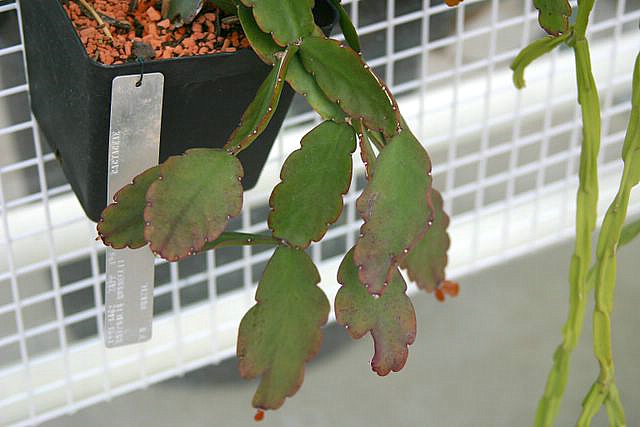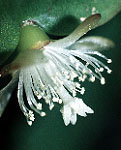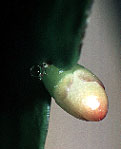See Calvente thesis 2010
11 . RHIPSALIS RUSSELLII Britton & Rose, Cactaceae
4: 242. 1923.
TYPE: BRAZIL. Bahia: near Toca da Onca (Jaguaquara), Rose 20106 (holotype: NY!;
isotype: US!).

R. russelii (copyright KAF, KEW 2006)
Epiphyte or lithophyte in open or shaded habitat,0.4-1.5 m long, branching apical. Stem segments flattened to triangular in longitudinal section (1-)2-5.5 cm diam, olive or pale green with reddish margin, succulent, stiff sometimes flexible, monomorphic 10-22 cm long, base attenuate, apex truncate, wings 2-3, 1-4 cm wide, margin crenate to lobed, plane to slightly undulate, with (3-)5-10 mm projections, midrib 3.5-7.5 diam, cylindric. Areoles between margin projections, 1.5-2.5 cm apart, first of segment 1-3(-8) cm distant from segment base; when sterile 2-3 mm diam, pilose, with vestigial scales; when fertile 2.5-3 mm diam, pilose, with numerous acicular scales, 2-10 flowers/fruits. Flowers 5-6 mm diam; pericarpel 3 X 2.5-3 mm, globoid, green, glabrous; with 3 sepaloid tepals, 0.6-1 mm long and 5 petaloid tepals, 2-3 X 2.1-2.5 mm, wide elliptic, patent to sub-erect, whitish, apex rounded, curved inwards, margin curved inwards. Style 2.3-2.5 mm long; stigma with 3-5 lobes, 0.8-1 mm long, ligulate, spreading. Ovules in 5 incomplete septa, funicle short (< 0.5 mm long). Stamens 9-12, 1.2-2.2 mm long, side by side, spreading, whitish. Nectary ca. 0.4 mm long. Fruit 6-10 X 6-9 mm, globoid, deep magenta, glabrous. Figure 2: D, H.
Notes: R. russellii can be easily identified by the small flowers (ca. 5-6 mm diam.), with few stamens, the deep magenta fruits numerous per areole, and the large and pilose areoles with numerous scales.
Habitat and distribution: Occurs in Minas Gerais, Espirito Santo and Bahia (Brazil), usually in dryer Atlantic forest (sensu lato). It can also occur as lithophyte in Bahia (Chapada Diamantina, Brazil). Figure 5.
Rhipsalis russellii Britton & Rose, Cact. 4:242 (1923)
Desc from Hunt 2006.
Body a sprawling lithophyte up to 80cm or pendent epiphyte up to 2m or more; branch segments 3-5 angled (lithophytes) or flattened, up to ca15 x 3-5.8cm, 2-3mm thick away from midrib, margins crenate; areoles with felt and occasional minute bristle spines, indented 3-11mm from edge of segment; flowers (1-) 3-9 together per areole, inconspicuous, up to ca 7x5-9mm, greenish white; stamens few, ca 12-14 or almost lacking; stigma 3-6, ca1mm; fruit in clusters, up to 7mm diam, whitish to pale pink, becoming red or purplish
Desc from B&R 1923
- Plant - hanging in great clusters from the horizontal branches of trees;
- Branches - strongly flattened, 15 cm. long, 5 to 6 cm. broad, cuneate at base, strongly crenate, dark green or purplish along margins;
- Flowers - often 9 at an areole, minute;
- Sepals - few, obtuse, reddish at tips;
- Petals - usually 5, cream-colored, obtuse, 2 mm. long;
- Fruit - usually 1 at an areole, small, globose, 5 to 6 mm. in diameter, purple.
Collected by J N Rose and Paul G Russell near Toca da Onca, Bahia, Brazil, June 27 to 29, 1915 ( No. 20106). This species suggests Rhipsalis elliptica but has very different flowers and fruit.



Notes from Bradleya 13
DISTRIBUTION. Brazil (Bahia, Minas Gerais, Espirito Santo): Atlanticand brejo forest, compo rupestre and ecotones with caatinga-agreste, low elevations to c 1000 m altitude.
A plant referable to Subg. Phyllarthrorhipsalis, which was collected in the state of Goias by P. Braun, is growing at the Univ. of Bonn collection and resembles R. russelli in its vegetative characters.